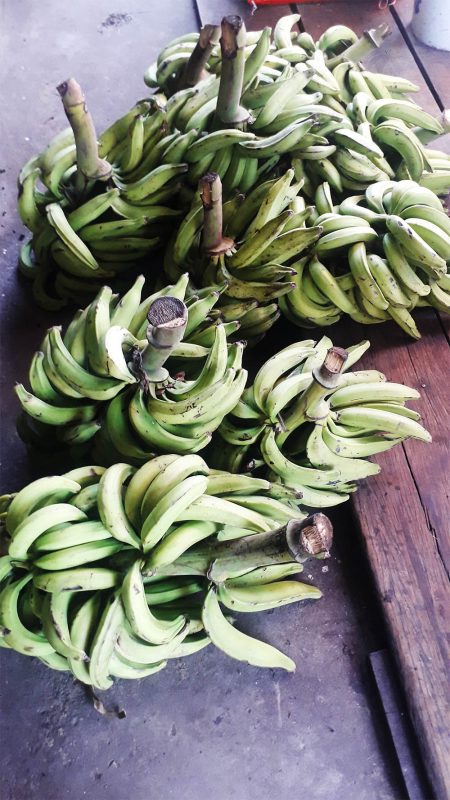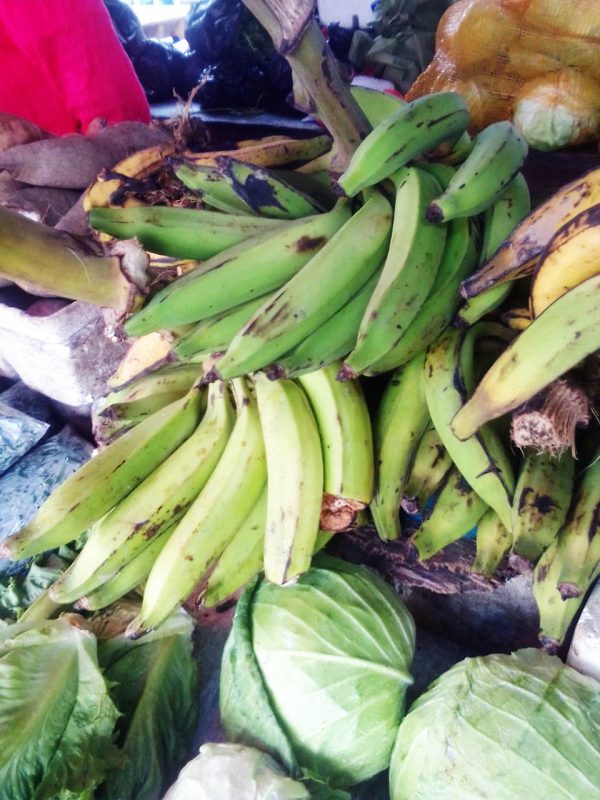By Subhana Shiwmangal
Varying reasons are being proffered for the continuing high price for plantains including the cost of fertilisers, inflation by middlemen and a fungus.
The Sunday Stabroek spoke to farmers, retailers, middlemen and supermarkets and the head of the National Agricultural Research and Extension Institute (NAREI) to understand what is contributing to the continued high price for this staple.
According to vendors from the Bourda, Stabroek and Parika markets, the Survival Supermarket and a middleman, the escalating plantain prices are directly related to three factors – the Black Sigatoka fungus, low supply in the face of high local demand, and the prohibitive costs for fertilizers. One farmer suggested that unseasonal rains actually worsened wholesale and retail prices. The head of NAREI however is refuting any relationship between the fungus and prices and redirects the responsibility towards unreasonable farmers and middlemen.
Samuel Murlie, a farmer, blamed the low quality of plantains on one of his farms at Bonasika, Essequibo on the fungus. Murlie told the Sunday Stabroek that plantains produced on his Bonasika farm are inferior in size compared to the plantains produced on his other farm on Leguan Island, Essequibo River. Murlie, when comparing prices for plantains from both farms, explained that the Bonasika plantains are sold at $80 per lb while that from Leguan Island carries a price of $180 per lb. Interestingly, Murlie also told the Sunday Stabroek that he has had to adjust the prices for both to minimize losses. Murlie explained that three months ago the Bonasika plantains were being sold at $100 per lb but had to be reduced to $80, while the larger Leguan plantains, which were being sold at $120 per lb were adjusted upwards to $180 per lb.
Christine Brindsley, a farmer from Parika and a vendor at the Stabroek Market explained that increases in plantain prices began during the COVID-19 pandemic and never fell. Brindsley told the Sunday Stabroek that in addition to the fungus, the prices for pesticides, fertilizers and general production costs have escalated making it more expensive to maintain her farm.
“I would have to lessen on the crop by planting less and raising the money to get the same profit because the government doesn’t help the farmers to cure the disease,” she said. According to Brindsley, during the pandemic plantains were sold at $260 [big] per pound and $200 [small] per pound in contrast to pre-pandemic prices of $100 per pound. Brindsley said that the increase in production costs is also captured in current market prices.
Another vendor, Bibi Singh from Bourda Market, said that her plantains are retailed at $240 and $140 per pound, while plantains directly from the stalk are sold at $190 per pound. She explained that wholesale prices range between $170 and $180 per pound. Three months ago, her plantains were being retailed at $200 per pound. Bibi told the Sunday Stabroek about some of her plantains being returned as they were showing signs of an infection. Bibi explained that the middlemen are blaming the high costs both on the fungus and on reduced supply.
She contended that middlemen are saying that Essequibo plantains are carrying the disease and that, “they [the farmers] said the plantain leaves has fungus”. The export factor, Bibi opined, has rendered the low plantain supply susceptible to market forces. One way that vendors have managed to stay afloat is by selling at retail prices as against selling by the bunches which are sold wholesale.
Survival Supermarket told this newspaper that a pound of plantain is currently being sold at $230 but three months ago, prices were $100 and $120 per lb. Although the supermarket could not offer any suggestions to explain the high costs, it did clarify that their purchasing prices ranged between $200 and $210 per lb.
Naresh, a wholesaler of plantains explained that prices are actually cheaper now compared to three months ago. “It depends on how you buy the plantains from the farmers,“ he explained. Naresh noted that right now he pays $160 per pound from the Essequibo Coast and resells at $180 a pound. He explained that the farmers are complaining about stock limitations because of the high cost for fertilizers. He said that “the few plantains that farmers have, whatever price they call, the vendors have to buy it.”
But the head of NAREI, Jagnarine Singh, is refuting the allegations that the Black Sigatoka is to be blamed for the high prices for plantains. Singh in fact suggested that it was the farmers or middlemen who are responsible for the escalating prices. Singh told the Sunday Stabroek that what some are suggesting as evidence of the fungus is what “… happens when the plantains are harvested and left on the ground.” The NAREI head explained that NAREI’s extensive programmes successfully eradicated the disease more than ten years ago and Guyana has been producing plantains because NAREI was able to control it. For instance, Singh said that the largest producing island for plantains is Wakenaam and to say that Bonasika is not producing enough plantains because of the disease, it’s not true.”
Singh also said that NAREI actually met with farmers and provided the sanitization support for farming plots. He added that “they have managed to sanitize the area by cleaning the fields, the issue is not that but the issue is the high prices sold by the middlemen or the farmers.”








